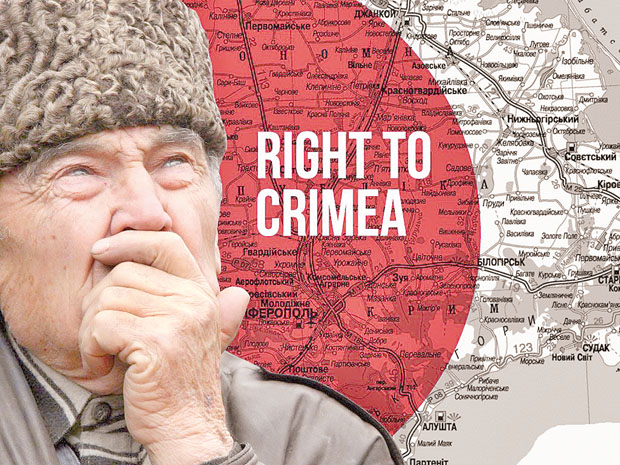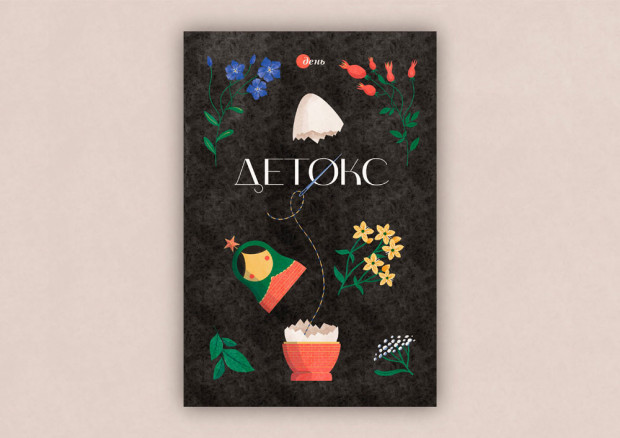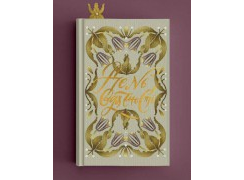The Right to the Crimea
Formation of the Crimean Tatar people
“Fraternal” Russia’s unprovoked aggression against the Crimea, on the pretext of defending the [ethnic] Russians against some mythical Banderites has once again brought to the fore the issue of the peninsula’s political status, the legitimacy of claims to this scenic land by various ethnic groups, specifically Crimean Tatars, Russians or Ukrainians. To clarify the matter, it is necessary to make a digression into Crimea’s distant and recent history. Historical evidence shows that the Crimean Tatars are at the top of this triangle.
The Crimean Tatar people began forming in the 13th century, after Batu Khan’s troops seized the steppe part of the peninsula in 1239, and following the assimilation of the Turkic-speaking aborigines, Polovtsians, and Mongols who had by then converted to Islam. In the 14th century, due to the dedicated efforts of Uzbeg Khan and Emir Timur (Tamerlane), Islam became the Crimea’s official religion. After the fall of the Golden Horde in 1443, there emerged the Crimean Khanate as an independent Crimean Tatar state. It was then national culture, art, architecture, and education system blossomed and folkways took shape. At the same time, the Muslim Crimean population showed a high level of tolerance in the religious domain. For example, the Dormition Cathedral near Bakhchysarai was supported by the khan and respected by Tatars; in Caffa (today’s Feodosia), there were 17 Catholic temples and two monasteries with Latin schools, also Greek temples and monasteries, Armenian and Russian churches, Jewish and Karaite synagogues. But in 1475 the Ottoman Empire seized the southern coast of the Crimea that was not part of the khanate and Mengli Giray Khan announced he was an ally of Turkey. Subsequently, the alliance turned into vassalage. In the 16th-17th cc. Tatars often raided Ukrainian territories in the Grand Duchy of Lithuania and Poland, and Crimea became number one supplier of slaves to the Ottoman Empire. A number of captives stayed in the Crimea. Eventually they received freedom but could not – and often did not want to – return to Rus’, as evidenced by Samiilo Velychko’s Chronicle that includes a story about Ivan Sirko’s campaign against the Crimean Tatars. Turkish traveler Evliya Celebi (Chalabi), referring to the 1666-67 census, wrote that there were 187,000 Muslims and 920,000 Ukrainian Eastern Orthodox adherents on the peninsula. The non-Muslim subjects of the Crimean khan – Jews, Karaites, Armenians, and Greeks – constituted 20,000. Ukrainian Cossacks also constantly raided the khanate, despite the alliance agreements between Bohdan Khmelnytsky and Islam III Giray.
Crimean Tatars often married Ukrainian women in captivity, which is proof of the specific relationships between the two peoples. Such marriages were registered not only between captives and Tatar warriors, craftsmen or merchants, but also the ruling elite, including the legendary marriage between Suleiman the Magnificent, one of the most noted Ottoman rulers, and Anastasia Lisowska who went down in history as Roxelana. Her son Selim would become Sultan Selim II. In the 17th c. Ukrainian women became wives of sultans Osman II, Ibrahim, and Mustafa II. Incidentally, Ibrahim’s spouse Turhan Hatice Sultan was the mother of his successor Mehmed IV. These women influenced family matters and those of the state. In the presence of such examples Crimean-Tatar-Ukrainian marriages appear to have been almost commonplace.
During various periods relationships between the Crimean Tatars and Ukrainians – and between the Christians and Muslims in the Crimea and the Ottoman Empire in general – were peaceful, even neighborly. That was the kind of policy Haji Giray Khan adhered to at the beginning of the Crimean Khanate. However, since the end of the 15th and during the entire 16th century these relationships became extremely strained due to constant raids by Crimean Tatars on Ukrainian territories, which caused great damage to the population and the economy of Ukraine. But as every cloud has a silver lining, this situation stimulated the emergence of Ukrainian Cossacks who would form the sociopolitical nucleus of the early modern Ukrainian nation. In the 1620s, Sahin Giray Khan of the Crimea, aided by Hetman Mykhailo Doroshenko’s troops, attempted to rid himself of Ottoman vassalage. Right-Bank Hetman Petro Doroshenko decided to revive Ukraine as a single state, with Crimean Tatar help, after the 1663 rift, with Left-Bank Hetman Ivan Briukhovetsky taking a traitorous pro-Muscovite stand. He did receive help, defeated the Polish army several times, and was able to beat off Muscovite attacks, but because of internal strife that was used by Muscovy and Poland to their best advantage, he had to abdicate hetmanate in 1676. Samiilo Velychko would later write that the Cossacks “smote themselves.”
The next thaw in Turkey-Ukraine relations occurred in the 18th century. Hetman Mazepa and his Cossacks found refuge in the Turkish town of Bender (Bendery) after the Battle of Poltava, despite his campaigns against Turkey, jointly with Muscovy, in the late 17th century. He died there on August 22, 1709. It was also in Bender that the Ukrainian Hetman in exile, Pylyp Orlyk, made an agreement of sorts with the Cossack starshyna (military elite), later to become known as the Constitution of Pylyp Orlyk. It was Europe’s first democratic constitution. It stressed that Ukraine on both sides “must at all times be free from alien domination.” After the Zaporozhian Sich was destroyed by the Russian empire in 1775, a number of Cossacks were taken over by Turkey and the sultan allowed them to form the Danubian Sich.
There was a Crimean Tatar diaspora in Ukraine. It took shape in the late 13th and first half of the 14th c., made up mostly of Crimean refugees who had refused to convert to Islam, also people taken prisoner of war during clashes with Lithuanians and Poles, defectors, and some nomads. They settled in Galicia (Halychyna), Volyn, and Podillia. The Crimean Tatar community in Lviv had their Tatarska vulytsia (Tatar Street, which is still there), fortified Tatarska brama (Tatar Gate), also a mosque and a cemetery. Similar communities formed in Lutsk, Ostroh, Dubno, Korets, Kamianets (-Podilsky), Polonne, Starokostiantyniv, Nemyriv, Medzhybizh (Miedzyborz), and Yahylnytsia (Jagielnica). However, after joint Cossack-Tatar combat operations in Poland (1648-49), the local Crimean Tatars found themselves exposed to ethnic and religious persecution. And so, during the Turkish offensive in 1672 they sided with their brothers in faith. In retaliation, the Poles butchered the Crimean Tatar communities in Miedzyborz and Jagielnica.
The concept that the Crimean Khanate was populated by nomad bandits appears to be markedly superficial. The khanate consisted of two parts: the Wild Steppe inhabited by warlike Nogais, who made up the bulk of the khan’s army, and Crimea proper, most of whose populace were peaceful gardeners, tillers, wine-growers, and shepherds. Traversing the Crimea were the civilizational roads linking the East and West. Built on its territories were [Old] Greek and Roman colonies, particularly the Byzantine ones dating from the 6th century, and Slavic settlements. It was from there that Christianity spread to Kyivan Rus’. In the 10th-12th cc., there existed the Tmutarakan Principality in the Crimea as part of the Kyivan state. Eventually, it accommodated Venetians and Genoese. The latter possessed the Gazaria (Cassaria) colonies in the 13th-15th cc. Caffa became Crimea’s major trade center. Jews started settling on the peninsula in the 13th c. Armenians followed suit in the 14th c. They contributed achievements of civilization – culture, art, literature, education, economic activity – to this territory that was free from the oppression of the dominant religion, economic coercion, and political censorship. Crimea was the first in Europe to abolish slavery and it never experienced serfdom. Crimean Tatars upheld equal relations among people regardless of ethnic origin, language or faith, as well as religious confessional, ethnic and cultural tolerance. They valued freedom and human dignity. Khan’s counselors, captains, treasurers were often “outsiders” – Christians and Jews. Freedom of conscience manifested itself in the fact that Muslims who converted to Christianity could not be persecuted whereas khans built and repaired Christian churches. The cities were self-governed and the land belonged to those who worked it. Under the laws of Sharia, the forests, bodies of water, and hunting grounds were common property.
To be continued. Follow this topic in “The Right to the Crimea” column.
* * *
Yurii Zaitsev, Ph.D. (Candidate of Historical Sciences), is a senior research fellow with the National Academy’s Krypiakevych Institute of Ukrainian Studies
Section
Topic of the Day





